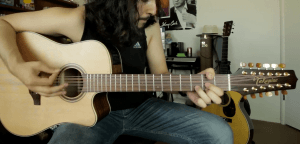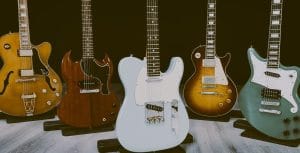Table of Contents
The effect of acoustic guitar body styles is significant in the instrument’s sound and aesthetics. Understanding these shapes and their relation with tone is essential whether you’re a seasoned guitarist or a beginner.
In this article, I will explore the range of acoustic guitar body styles, demystifying various body shapes to help you choose one that suits your musical style. You’ll find everything from the common ones to the near-obsolete ones here!
What are the different acoustic guitar body styles?
Acoustic guitars come in a diverse array of body shapes and sizes. Some emphasize portability, some focus on sound resonance, some cater to higher playability, and some just want to look cool. Each uniquely influences the instrument’s tone, playability, and overall feel.
Here’s a quick overview of some of the most common acoustic guitar body shapes:
Dreadnought
The dreadnought guitar shape is an enduring symbol of acoustic excellence. Its distinctive, robust design features a broad body with square shoulders, contributing to its iconic appearance and powerful sound. Dreadnoughts are prominent guitars with upper bouts that are only slightly smaller in width than the lower bouts.
This shape was first popularized by the Martin Guitar Company in the early 20th century and has since become a staple in acoustic guitars.
The scale length of a dreadnought is usually around 645mm (25.4″) with body depth approx 121- 124mm (4.9″). Round shoulder dreadnoughts also exist, though rare to find.
Why Are Dreadnoughts Special
Known for its volume, deep bass, and pronounced midrange, the dreadnought excels in genres that demand strong projection. It is a preferred choice for artists dabbling in folk, country, and bluegrass music. Pop artists who incorporate many strummed sections have also found much love for it.

Grand Concert
The grand concert guitar shape is a refined and versatile acoustic instrument design. Characterized by its compact, narrow-waisted body, it offers excellent playability and sonic intricacies. This shape’s structural attributes create a tonal profile marked by balanced frequency distribution, ensuring clarity and articulation.
Why Are Grand Concerts Special
Its pronounced midrange and well-defined tonal spectrum make it a preferred choice for fingerstyle guitarists and soloists who require precise note articulation. Its short scale and lighter string tension help achieve technical excellence across various musical genres, including classical, folk, and contemporary acoustic styles.
Check out the best classical guitar strings here.

Grand Auditorium Cutaway
The grand auditorium cutaway guitar, a descendant of the classic grand auditorium design, boasts a unique and practical feature—a cutaway that allows easier access to frets past the 12th fret.
Originating in the early 20th century, this design was popularized by brands like Taylor Guitars. Renowned artists like Taylor Swift, Jason Mraz, and Dave Matthews have embraced the grand auditorium cutaway for its versatility and balanced tone.
Why Are Grand Auditoriums Special
The balance between resonance and high-notes accessibility and its ability to blend rich, warm lows with crisp, clear highs makes it an ideal choice for musicians spanning diverse genres, from pop to folk and beyond.

Parlor Guitars
Parlor guitars, originating in the 19th century, were designed for intimate gatherings and parlors, hence their name. While their small bodies limit projection, i.e., volume, they offer a unique charm and tonal warmth that resonate with aficionados of folk, blues, and vintage styles.
Famous for their portability and vintage aesthetics, parlor guitars are 18 1/4″ or less long, 4″ deep, 9 1/2″ or less upper body width, and 13 1/4″ or less low body width.
Why You Must Hava A Parlor Guitar
Artists who travel around a lot or feel comfortable playing on small-bodied guitars love the parlor guitars. The guitar is ideal for players who perform in small venues or close gatherings.

Concert, or Model “O”
Concert guitars represent a timeless and revered category within acoustic instruments. Characterized by their smaller, symmetrical slope-shouldered bodies, these guitars offer a distinctive playing experience. They feature nylon strings that produce a warm and mellow tone, making them ideal for classical, fingerstyle, and flamenco music.
Check out some budget classical guitars here.
What Makes A Concert, or Model “O” Unique
With a shorter scale length and a more expansive, flat fingerboard, concert guitars facilitate precise fingerpicking and intricate chord progressions. Renowned for their rich resonance and sustain, they have become vessels for expressing the beauty and emotion of classical and flamenco compositions.

Grand Concert, or Model “OO” Guitars
The Grand Concert Model 00, often called “Model 00,” represents a classic and iconic design in acoustic guitars. This guitar shape is characterized by its smaller, more intimate body size, making it highly appealing to musicians who prioritize comfort and precision.
What Makes Grand Concert, or Model “OO” Guitars Unique
With a typically shorter scale length, a narrow waist, a cutaway, and a well-balanced tonal spectrum, Model 00 guitars excel in delivering a clear and articulate sound. This makes them well-suited for fingerstyle playing, intricate picking techniques, and solo performances.

Orchestra Model, Grand Auditorium, or Model “OM” or “GA”
In the 20th century, the Orchestra Model was originally intended to be a large guitar capable of being heard over other orchestral instruments. It is a technically sophisticated acoustic guitar design celebrated for its tonal equilibrium and ergonomics.
The OM boasts a narrow waist and meticulous bracing patterns contributing to its exceptional sound. Its body is smaller than a dreadnought, with a 15-inch-wide lower bout and a body depth that tapers from 4-1/8 to 3-1/4 inches.
What Makes An Orchestra Model, Grand Auditorium, or Model “OM” or “GA” Unique:
This model’s tonal signature is typified by a pronounced midrange, making it a prime choice for fingerstyle aficionados and soloists.

Jumbo and Super-Jumbo
In acoustic guitars, jumbo and super jumbo models stand tall. These giants, known for their broad-shouldered bodies, deliver commanding soundscapes.
Jumbo Guitars
Originated by Gibson in the 1930s, jumbo guitars offer booming bass and robust projection. Ideal for country and bluegrass, they’ve become an emblem of acoustic authority.

Super Jumbo Guitars
The biggest of the big guitars, “super jumbos,” take size to the extreme, boasting even larger bodies and unmatched volume. Artists like Elvis Presley and John Hiatt favor them for their stage presence.

Where they shine: Though not for everyone due to their size, these guitars are unparalleled for filling rooms with thunderous resonance and melodic might.
Choosing the Shape That’s Right For You
Picking one out of the numerous acoustic guitar body styles is a difficult choice. You should do it with careful consideration of your playstyle, tone preference, performance setup, and aesthetics. You already know which shape offers what perks, so go all out!
How do cutaway and non-cutaway guitars differ from each other?
Cutaway guitars have a “cut” in the body near the neck, allowing easier access to higher frets. Non-cutaway guitars have a traditional body shape, offering a fuller sound but limiting access to those higher notes. A cutaway might be beneficial if you’re into lead guitar or soloing. For a rich, full-bodied tone, you may prefer a non-cutaway.
Can you explain the distinctions between Dreadnought and Slope-shoulder guitars?
Dreadnought guitars have a square-shouldered design and a larger body, which produces a bold, loud sound perfect for strumming and flatpicking. Slope-shoulder guitars, conversely, have rounded or “sloped” shoulders, yielding a mellower tone. They’re often favored for fingerpicking and softer styles. Which one is better? It depends on your musical needs.
What sets the O/0 acoustic models apart from each other?
The terms “O” and “00” refer to the body sizes of acoustic guitars, with “O” being smaller and “00” being slightly larger. The smaller O size often produces a brighter, more focused sound suitable for fingerstyle and solo performances. The 00 size offers a bit more volume and is low-end, making it versatile for strumming and fingerpicking. Both are more compact than a Dreadnought, but each has unique tonal qualities.
Could you differentiate between Classical, Spanish, and Flamenco guitars?
While all three types of guitars have roots in Spanish tradition, they vary in construction and tone. Classical guitars usually have nylon strings and a wider neck, tailored for classical music and fingerstyle techniques. Spanish guitars are a broad category that generally includes classical guitars, but they can also refer to any guitar developed in Spain. Flamenco guitars are a subtype of classical guitars but are built to produce a brighter, more percussive sound, catering to the quick-finger techniques used in flamenco music.
FAQ
The choice of body material for an acoustic guitar isn’t a matter of one being definitively “best,” as it largely depends on your personal preferences and the type of sound you desire. Different woods offer distinct tonal characteristics, and each has its own unique qualities.
Yes, body shapes affect guitar sound. Different shapes offer different projections, tonal characteristics, playability, and portability.
Heavier guitars are generally praised for their richer, fuller sound, which is due to the relatively massive size of the wood used to anchor the pickups, strings, and, consequently, the tone itself.
- 6 Unique Guitar Picks That Will Blow Your Mind - February 6, 2025
- Master the Harmonic Major Scale And Intervals - February 6, 2025
- 9 Eye Catchy Unique Guitar Straps for Every Musician - February 6, 2025









